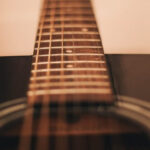For guitarists venturing into the world of digital recording, a guitar audio interface is an indispensable piece of equipment. Essentially, a guitar audio interface acts as the bridge connecting your guitar and other audio sources to your computer, enabling you to record, process, and mix your music digitally. Selecting the right interface can feel daunting given the array of options available, but understanding the key features and considerations will simplify the process. At its core, an audio interface converts analog audio signals into a digital format that your computer’s recording software can recognize, and vice versa when you want to listen back. These conversion processes are handled by AD/DA (Analog-to-Digital/Digital-to-Analog) converters. Higher quality interfaces boast superior converters with “jitter correction,” minimizing timing inconsistencies for a cleaner and more accurate audio representation.
However, modern audio interfaces offer much more than just basic conversion. They often integrate microphone preamps, multiple input and output (I/O) connections – including balanced, unbalanced, and digital options – and even onboard Digital Signal Processing (DSP) for effects, EQ, and monitor mixing. Some advanced units can even function as standalone mixers for live sound applications, independent of a computer.
One of the primary factors determining the sonic quality of a Guitar Computer Interface is the caliber of operational amplifiers (op-amps) used in its design. Premium interfaces utilize low-noise, low-distortion components, and sometimes even discrete components instead of integrated chips, leading to a more transparent and detailed sound. The number of I/O connections is another crucial consideration. Basic interfaces typically offer 2-in/2-out configurations, suitable for recording a single vocal and instrument simultaneously or a stereo microphone setup for capturing live performances. As your needs grow, you can find interfaces with significantly expanded I/O capabilities. Interfaces with 18 inputs and 22 outputs are readily available and cater to most home studio and project studio requirements. For larger, more complex setups, professional systems like Pro Tools HD rigs offer even greater expansion possibilities.
Connectivity is the final, but equally important, aspect to consider. Several connection types are used for computer guitar interfaces, each with its own advantages and disadvantages:
- USB: USB interfaces are popular for their portability and widespread compatibility. Many mobile interfaces utilize USB connections. However, they might be less ideal for scenarios demanding a very high number of simultaneous inputs and outputs.
- FireWire (IEEE 1394): FireWire offers robust speed and bandwidth, often preferred for higher channel counts. However, FireWire interfaces generally require an external power supply.
- Thunderbolt: Apple’s Thunderbolt connection, increasingly common on newer computers, provides exceptional speed and low latency, making it a top choice for professional audio applications.
- PCI/PCIe: PCI and PCIe cards offer the highest bandwidth and lowest latency, but are limited to desktop computers and fixed studio environments.
Numerous reputable brands produce high-quality audio interfaces. Some popular names in the market include Akai, Apogee, Avid, Focusrite, M-Audio, MOTU, Presonus, Roland, Tascam, and Yamaha. Ultimately, the best audio interface for guitar is the one that aligns with your specific needs and workflow. To find the perfect match, it’s recommended to consult with pro audio specialists who can provide tailored advice based on your recording goals and budget.
For users requiring even more advanced solutions, specialized professional systems like Avid HDX and Focusrite Rednet are available through expert providers. These systems are designed for demanding environments such as professional recording studios and post-production facilities.

